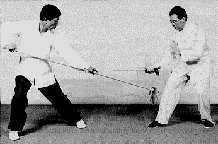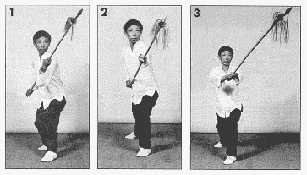Bok-Nam Park and Ken Fish
[Adapted and re-edited by F. Hriadil]

Block, press, thrust, and pierce. Block, press, thrust, and pierce. Block, press, … This endless sequence is the core of spear (qiang) training, regardless of the system. Nonetheless, it would be a mistake to assume that all spear systems are cut from the same cloth. While spear techniques may vary little from system to system, the manner in which force is generated and applied can change tremendously.
In the Ba Gua Zhang method of Lu Shui-Tian as taught by Master Bok-Nam Park, Ba Gua Qiang (Ba Gua Spear) uses the rolling, springing, coiling, whip-like forces generated in the open-hand methods and transmits these forces along the length of the weapon. What would otherwise be force applied at short range is thus brought to the end of the spear, a considerable distance from the spear players’ body.
Basic Techniques
The basic techniques of the Ba Gua “Twelve Flowing Movements” Spear (Ba Gua Shi Er Lian Qiang) are similar to those of the major Shaolin systems, such as the Yang family spear or the Liu He (Combined Six Systems) spear. What sets Ba Gua Spear of Lu Shui-Tian apart from these is the quality of movement mentioned above.
The basic techniques of Ba Gua Qiang are:
- Lan – To block to the outside
- Na – To block to the inside
- Zha – To stab or pierce
- Chan – To bind or trap
- Dian – To flick (the spear is shaken and whipped, flicking the tip at the enemy)
- Ce – To slash or cut with the edges of the spear tip
- Pi – To split, striking forward and down
These techniques employ the following kinds of trained strength or “jing:”
- Lan
- Coordinated force of the waist, hips, and arms which moves the spear tip in a outward arc from right to left (“inside” to “outside”)
- Na
- Coordinated force of the waist, hips, and arms which moves the spear tip in a inward arc from left to right (“outside” to “inside”)
- Ya
- To press
- Compressing the torso vertically and pressing the body weight into the legs to augment a downward pressing motion
- Tiao
- To swing or toss up
- Combines pressing on the rear end of the spear shaft with lifting of the front end using a coordinated pulling and lifting motion. Power is generated by the hips, shoulders, and back.
- Yao
- To swing to and fro
- Uses the combined action of the hip, waist, and arms to whip the spear tip from side-to-side
- Beng
- To thrust with a following step
- The spear is propelled forward as the spear player steps in, turning at the waist and hips to generate thrust. The follow-step adds stability and enables greater mobility.
- Zha
- To stab or pierce
- Combines forward thrust from the rear leg with squeezing and thrusting from the shoulders and arms.
- Zhen
- To shake
- Generating a whipping motion from the heel to the of the spear with the arms at or near full extension. This “jing” seems to be unique to Ba Gua, and allows the spear player to generate force to the end of the weapon from a posture where most other systems would retract to strike again.

Lan-Zha sequence.
Above he executes:
- Lan – blocking outward,
- Ya – advancing and pressing downward,
- Zha – thrusting and piercing forward.
Sizing The Weapon
The appropriate length for a Ba Gua Spear is approximately nine feet, measured from the butt of the shaft to the tip of the spear. The spear should be made from a hard wood with some resilience. Willow is sometimes used. The tassel should be made from horse hair, usually the tail, and is fixed in place with horse hide just behind the spear tip.
As one might gather, holding a nine foot spear at full extension places considerable weight and pressure one one’s wrists. The traditional means of training for this is to simply hold a spear or staff at full extension (or as close to full extension as possible) for as long as one can. When one is able to hold the full length of the spear in this fashion without too much difficulty, one then attempts the same with one hand.
Learning to manipulate the spear head in small, tight circles is crucial to success in combat, not unlike the tip movement in modern fencing. Ideally, the size of the circle described by the spear tip should be no larger than six or seven inches. Accuracy in thrusting the business end of the spear is perhaps even more essential. Master Bok-Nam Park teaches this by hanging small rings no more than five inches in diameter, to the front, back, and sides of the student. The student must train to jab or poke through the center of the rings at full speed, turning and shifting with each successive strike. Only when this training is mature will be movements be true and accurate. There are other training methods for particular techniques. A good example is the “Beating the Grass in Search of Snakes” (Bo Cue Xuan She) technique. Bamboo poles are set into the ground at varying distances and with varying amounts of space between. The student moves between the poles, executing the technique at full force against the poles. The student strives to bend the poles with each strike to train the necessary strength and mobility.

Master Park shows the ” Beating the Grass in Search of Snakes” technique. The spear tip is:
- thrust forward, then
- rapidly whipped to and fro to
- cut an enemy’s legs.
Fluidity and Mobility
In Ba Gua spear, the emphasis is on fluidity and mobility. Hand techniques are secondary and subservient to footwork and body motion. If one misses the mark on an attack, one must compensate with footwork. The spear player must be able to wield his weapon at any range and be flexible in his tactics and footwork. The maxim guiding spear use in combat is that the spear player should be able to use this long weapon at short range or he will be open to counterattack at the end of each thrust.
As in Ba Gua unarmed training, stance and footwork must be accurately performed to create maximum power and mobility while exposing as little of the practitioner’s body to attack as possible. One’s nose, forward foot, and the tip of the spear form the apices of a triangle, and must be vertically aligned along one’s centerline. Although some authors describe the spear as a staff with a knife at one end, the spear actually has little in common with knife or staff fighting. Whereas the staff moves to attack and cover a plane in space, the spear strikes along a single line to a point. It follows, then, that the means of control is also different. The forward wrist is used to direct the spear and move the opponent’s weapon, as well as to move the tip in a circle for attack and defense. Movements to the left, right, up, and down are controlled by the back hand.
Power
Ba Gua Spear power generation differs markedly from most other systems of Chinese martial arts. In most systems, the power is generated by thrusting from the rear heel and pushing with the hip, rear hand, and rear arm. In Ba Gua spear, force is applied only at the end of the movement, and is a wavelike, rolling, whipping force originating in the Ba Gua practitioner’s lower back and spine. The wrist and shoulder may add force or may be employed to continue the strike. It is this last means of striking which allows the Ba Gua Spear practitioner to strike repeatedly without having to retract the spear.
The other signature qualities of Ba Gua open-hand fighting are also employed: circling, sliding, sticking, and tying up the enemy. As Ba Gua makes frequent use of turning and maintaining a position oblique to the enemy, the butt end of the spear is also given ample opportunity for use.
Most Difficult Weapon
The spear is Master Park’s weapon of choice. Watching him perform the Ba Gua “Twelve Flowing Movements” Spear with grace and power, one immediately understands why a good spear player is said to “crouch like a tiger and move like a dragon whipping its tail.” Thrusting and jabbing, the spear player moves like a “dragon emerging from beneath the waves” with the spear shooting forth like a “dragon putting forth its claws.”

Master Park considers the spear to the the most difficult of all weapons. In fact in China, the spear is sometimes called “Jiu Nian Qiang,” or “Nine Year Spear,” indicating the length of time needed to master the weapon. As Master Park explains, it is one thing to maneuver the spear and execute the techinques; it is quite another to feel as if the spear is an extenson of one’s arms. This comes, as with all achievement in martial arts, only with time and arduous practice.

